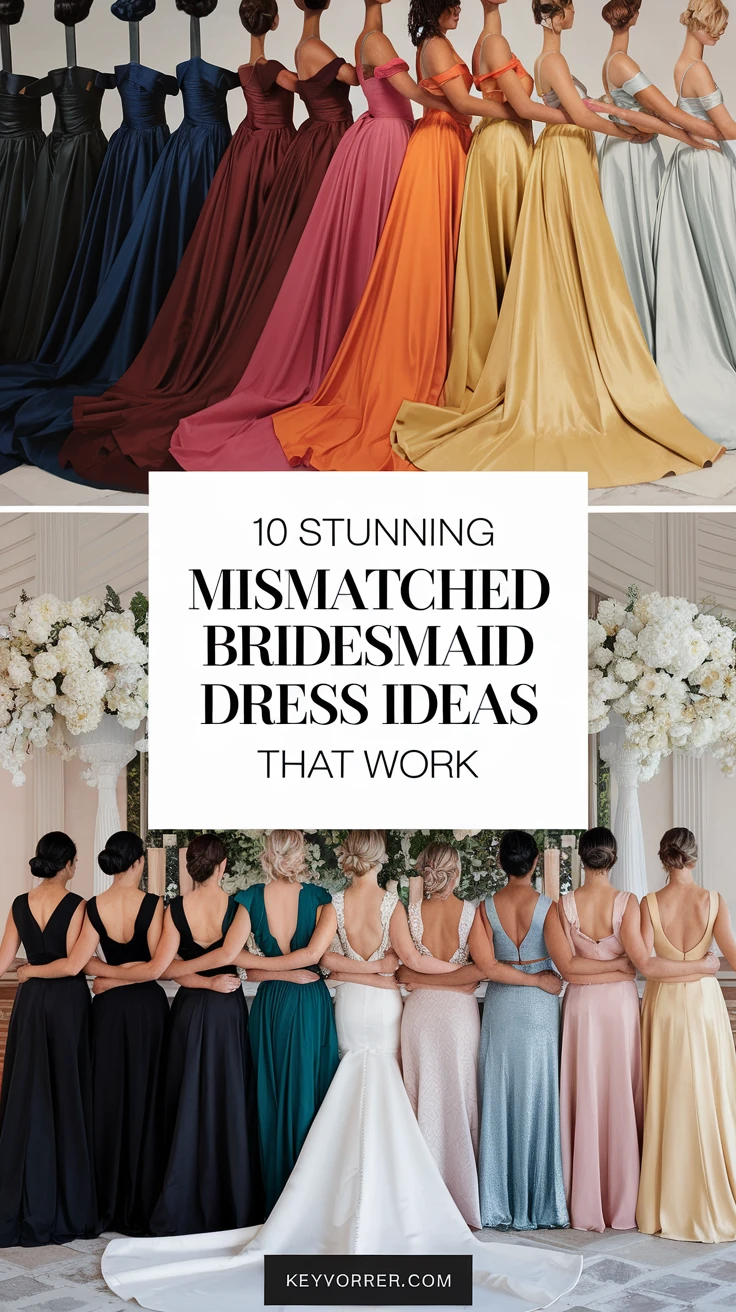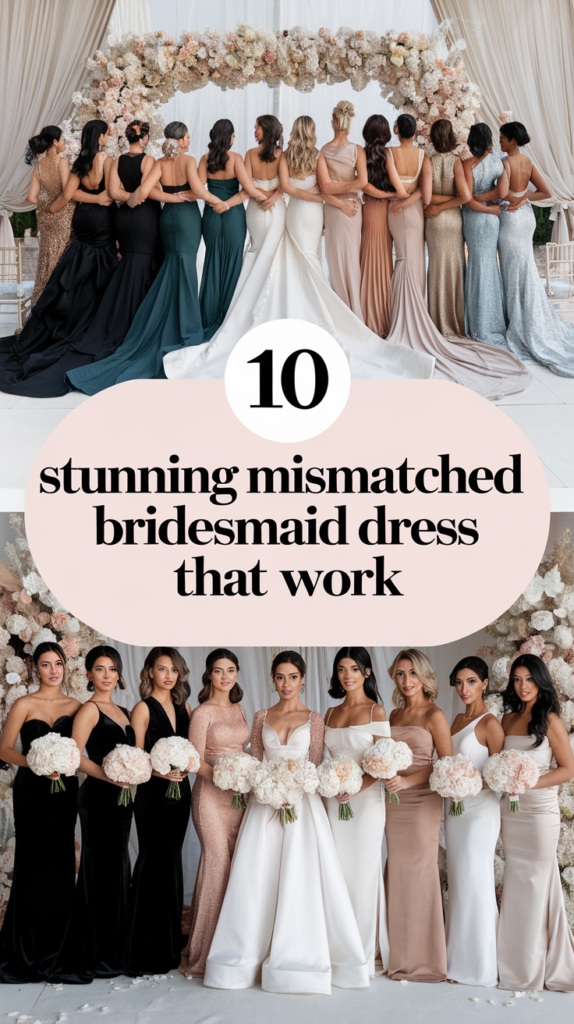
Gone are the days when bridesmaids were expected to wear identical dresses that often didn’t flatter their different body types or personal styles. The trend of mismatched bridesmaid dresses has revolutionized wedding fashion, offering a fresh, modern approach that celebrates individuality while maintaining a cohesive bridal party look. As someone who’s helped coordinate numerous weddings and witnessed the evolution of bridal fashion, I can confidently say that mismatched dresses create more vibrant, personality-filled wedding photos and happier bridesmaids who feel comfortable and confident on the big day.
Let’s explore ten stunning ways to coordinate mismatched bridesmaid dresses that will create a harmonious yet unique look for your wedding party. Whether you’re planning an elegant ballroom affair or a casual beach celebration, these ideas will help you achieve that perfectly “imperfect” ensemble you’re dreaming of.
1. Same Color, Different Styles
The most approachable way to dive into mismatched bridesmaid dresses is to choose a single color but allow different dress styles. This approach ensures cohesion while letting each bridesmaid select a cut that flatters their body type.
Consider these options for implementing this style:
– A-line dresses for pear-shaped figures
– Empire waists for apple shapes
– Fitted sheaths for athletic builds
– Wrap dresses for hourglass figures
To make this work effectively, provide your bridesmaids with specific color swatches or a designated retailer’s color code. I once coordinated a wedding where the bride chose “dusty rose” but didn’t specify the exact shade – the resulting mix of pink tones wasn’t quite what she envisioned. Learn from this mistake by being precise with your color selection.
| Body Type | Recommended Style | Features to Look For |
|---|---|---|
| Pear | A-line | Flowing skirt, fitted bodice |
| Apple | Empire waist | High waistline, flowing fabric |
| Athletic | Sheath | Clean lines, minimal detail |
| Hourglass | Wrap dress | Adjustable waist, V-neckline |
2. Ombré Effect
Creating an ombré effect with your bridesmaid dresses offers a stunning visual impact that photographs beautifully. This technique involves selecting dresses in graduating shades of the same color family. For example, start with the darkest shade of blue and gradually transition to the lightest.
Key tips for achieving the perfect ombré look:
– Choose a color family with at least 4-5 distinct shades
– Arrange bridesmaids by height to create a flowing gradient
– Consider the wedding venue’s lighting
– Factor in seasonal colors
| Color Family | Dark Shade | Medium Shade | Light Shade |
|---|---|---|---|
| Purple | Plum | Mauve | Lilac |
| Blue | Navy | Steel Blue | Powder Blue |
| Pink | Burgundy | Rose | Blush |
3. Complementary Color Palette
Working with complementary colors creates a rich, dynamic look that adds depth to your wedding photos. Select 2-3 colors that work together harmoniously, allowing bridesmaids to choose from this mini palette.
Essential considerations for complementary colors:
– Choose colors that appear elsewhere in your wedding decor
– Consider the season and venue
– Test how colors photograph together
– Include at least one neutral option
Popular complementary combinations:
– Sage green and dusty rose
– Navy and blush
– Burgundy and champagne
– Lavender and silver
4. Mix of Patterns and Solids
Incorporating patterns alongside solid colors adds visual interest and personality to your bridal party. This approach works particularly well for bohemian or garden weddings. The key is to maintain a consistent color palette while varying the patterns.
Guidelines for mixing patterns:
– Limit patterns to 2-3 varieties
– Keep patterns in the same color family
– Balance busy patterns with simple solids
– Consider scale – mix large and small prints
5. Different Lengths
Varying dress lengths creates dimension and visual interest while allowing bridesmaids to choose styles they’ll actually wear again. This approach works especially well for mixed-season weddings or when you want to incorporate both formal and casual elements.
Length combinations to consider:
– Floor-length
– Tea-length
– Knee-length
– High-low styles
Remember to consider the formality of your venue and the season when mixing lengths. A winter ballroom wedding might lean towards longer styles, while a summer garden party could incorporate shorter options.
6. Various Necklines
Different necklines allow bridesmaids to choose styles that complement their body types and comfort levels. This subtle variation maintains cohesion while providing personalization.
Popular neckline combinations:
– V-neck
– Halter
– Sweetheart
– One-shoulder
– Strapless
When mixing necklines, consider providing guidelines about the overall style (romantic, modern, classic) to maintain a cohesive look.
7. Mixed Fabrics
Incorporating different fabrics adds texture and depth to your bridal party’s look. This approach works particularly well when keeping colors consistent.
Fabric combinations that work well:
– Chiffon
– Satin
– Lace
– Velvet
– Sequins
Remember to consider the season and comfort level – heavy fabrics for winter, lighter ones for summer.
8. Vintage-Inspired Mix
Creating a vintage-inspired mismatched look allows for incorporating unique pieces and personal style while maintaining a cohesive theme.
Elements to consider:
– Lace details
– Beading
– Tea-length styles
– Retro silhouettes
– Vintage-inspired accessories
9. Neutral Palette Variations
Using different neutral tones creates an elegant, sophisticated look that’s perfect for formal weddings.
Popular neutral combinations:
– Champagne
– Ivory
– Taupe
– Grey
– Blush
This approach works particularly well for black-tie affairs and photographs beautifully.
10. Bold Color Blocking
For the fashion-forward bride, color blocking creates a modern, striking look that makes a bold statement.
Tips for successful color blocking:
– Choose colors that complement each other
– Consider the overall wedding palette
– Balance bright colors with neutrals
– Use accessories to tie looks together
Conclusion
Embracing mismatched bridesmaid dresses offers endless possibilities for creating a unique and personalized wedding party look. The key to success lies in maintaining some element of cohesion while allowing for individual expression. Whether you choose to vary styles, colors, or both, remember that clear communication with your bridesmaids and attention to detail will help achieve the perfect balance of coordination and personality.
Key Takeaways
- Always provide clear guidelines and specific color codes to ensure cohesion
- Consider your bridesmaids’ body types and comfort levels when selecting dress options
- Test how different combinations photograph together before making final decisions
- Start the dress selection process early to accommodate different ordering times and alterations
- Remember to balance personal expression with overall wedding aesthetics
Frequently Asked Questions
-
How far in advance should bridesmaids order their dresses?
Order dresses 6-8 months before the wedding to allow time for shipping, alterations, and addressing any potential issues.
-
How can I ensure all the dresses will look cohesive in photos?
Provide specific color swatches, do a group try-on if possible, and consider having your photographer present during dress selection to advise on how different options will photograph.
-
Should I set a budget range for mismatched dresses?
Yes, establish a reasonable price range that accommodates all bridesmaids’ budgets and communicate this clearly from the start.
-
How many different colors or styles are too many?
Generally, stick to 2-4 colors or styles to maintain a cohesive look without appearing chaotic.
-
Can bridesmaids wear dresses they already own?
Yes, if they fit within your specified guidelines for color, style, and formality level.
-
How do I handle alterations for different dress styles?
Each bridesmaid should handle their own alterations, but provide recommendations for trusted tailors and timeline guidance.
-
What’s the best way to coordinate accessories with mismatched dresses?
Choose one consistent element (like jewelry or shoes) to tie the looks together while allowing variation in other accessories.
-
Should the maid of honor wear a different color or style?
This is a personal choice, but many brides choose to distinguish the maid of honor with a slightly different shade or complementary style.
-
How can I make sure everyone feels comfortable with their dress choice?
Involve bridesmaids in the selection process and be open to their feedback about styles that work best for their body types and comfort levels.
-
What if a bridesmaid struggles to find a dress within the guidelines?
Be flexible and work with them to find alternatives that maintain the overall look while accommodating their needs.


